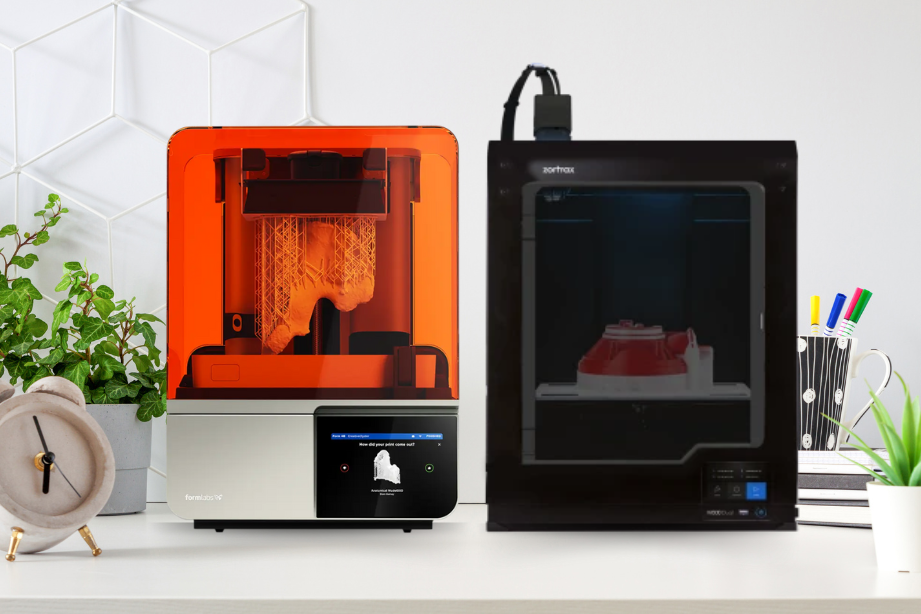3D printing has revolutionized industries with its versatility, precision, and efficiency. Among the leading brands in this space, Zortrax and Formlabs have carved niches by catering to specific applications and user needs. If you’re exploring which of these brands suits your requirements, here’s a detailed guide to help you make an informed choice.

Understanding Zortrax: Durability Meets Performance
Zortrax is known for its user-friendly design, robust build, and industrial-grade reliability. It is ideal for professionals seeking durable and consistent 3D printing.
Applications of Zortrax
- Prototyping for Manufacturing
- With high dimensional accuracy and excellent surface quality, Zortrax printers like the M Series are perfect for creating prototypes that replicate the functionality of final products.
- Materials like Z-ABS, Z-HIPS, and Z-PCABS cater to diverse prototyping needs.
- Mechanical Engineering
- Zortrax printers are compatible with materials offering high mechanical strength, making them ideal for functional parts and tooling.
- The Endureal model supports PEEK and carbon-fiber reinforced materials, enabling the creation of components for aerospace and automotive sectors.
- Architecture and Design
- Architects and designers appreciate Zortrax for its ability to produce intricate, durable models suitable for presentations and planning.
Formlabs: Precision with Versatility
Formlabs focuses on resin-based SLA (Stereolithography) and SLS (Selective Laser Sintering) technologies, offering exceptional precision and surface finish. It’s a go-to choice for industries that demand high-detail prints.
Applications of Formlabs
- Healthcare and Dentistry
- With biocompatible resins, Formlabs printers are extensively used for creating dental aligners, surgical guides, and prosthetics.
- Printers like the Form 4B and Form 4BL excel in dental and medical applications.
- Jewelry and Fine Arts
- The Form 4 and Form 4L its castable resins enable jewelers to create intricate wax models for investment casting.
- Artists benefit from the precise detailing Formlabs printers offer for sculptures and miniature designs.
- Product Development and Engineering
- SLA technology ensures that engineers and designers achieve prototypes with smooth surfaces, ideal for testing ergonomics and aesthetics.
- The Fuse 1 SLS printer is great for creating durable, end-use parts.
Comparative Summary
| Feature | Zortrax | Formlabs |
|---|---|---|
| Printing Technology | FDM, LPD Plus, LPD | SLA, SLS |
| Material Range | Thermoplastics, PEEK, Carbon Fiber | Resins, Biocompatible Materials |
| Best for | Functional prototypes, Mechanical parts | High-detail models, Medical/Dental use |
| Surface Finish | Excellent, slightly textured | Smooth, intricate |
| Ease of Use | Beginner to advanced | Advanced users |
| Price Range | Mid to high | High-end |
Which One Should You Choose?
- Choose Zortrax if you need durable, functional prototypes or mechanical components for industrial applications. Its compatibility with a broad range of materials makes it versatile for engineers and manufacturers.
- Choose Formlabs if your focus is on precision, aesthetics, or biocompatibility. It is an excellent choice for healthcare, jewelry, and fine arts where detail and surface finish matter most.
Both Zortrax and Formlabs have their strengths, and selecting the right one depends on your specific application needs, budget, and desired level of detail. With these insights, you’re better equipped to make the right choice for your 3D printing journey.
Products we offer at Ashtech 3D Innovations in Pune, Mumbai, Nashik, Aurangabad, Nagpur, Kolhapur, Goa, Belagavi, Vishakhapatnam, Guwahati, Chhattisgarh, Delhi, Vadodara, Faridabad, Bangalore, Thiruvananthapuram, Chennai, Hyderabad,
Zortrax FDM 3D Printer (M300 Dual,M300 Plus, M200 Plus), Formlabs SLA 3D Printer (Form 4, Form 4L,Form 4B, Form 4BL), Thor 3D Scanner (Calibry, Calibry Mini). FDM 3D Printing Services, SLA 3D Printing Services, SLS 3D Printing Services, MJF 3D Printing Services, Metal 3D Printing Services, Vacuum Casting Services , 3D Scanning Services, Reverse Engineering Services & All Type Of Prototyping Services.
